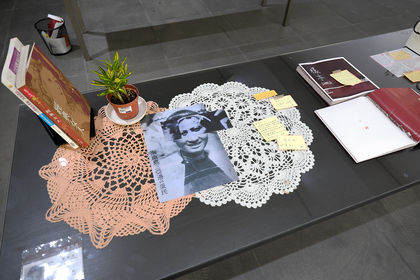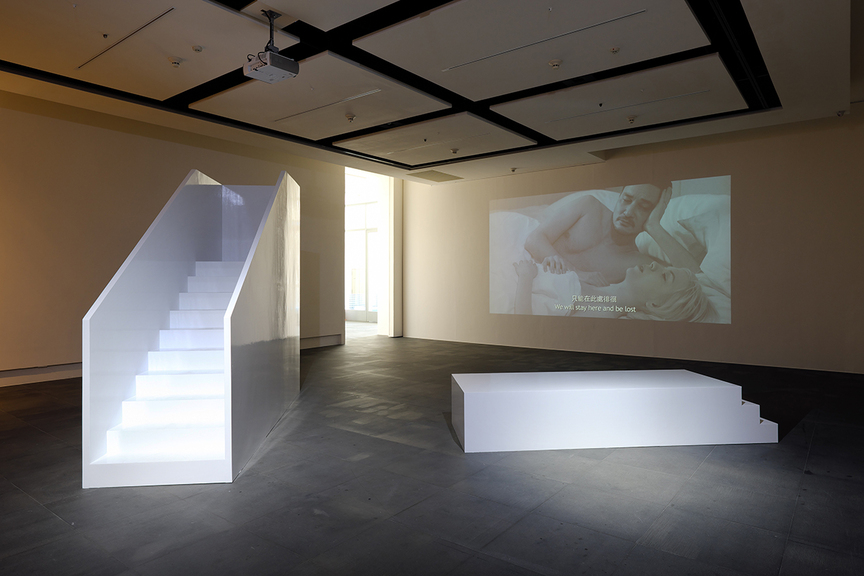-
From Current Issue
-
- Editor’s Letter Fire in the Heart
- Reviews I Gusti Ayu Kadek Murniasih
- Reviews 11th Seoul Mediacity Biennale: “One Escape at a Time”
- Dispatch Networked China
- One on One Monira Al Qadiri on Yukio Mishima
- Essays The rise of independent art spaces in pandemic-era Shanghai
- Features Tuan Andrew Nguyen
- Table of Contents
- Web Exclusives
- Archive
- Subscribe

R
E
V N
E
X
T
CHANG WEN-HSUAN, The Compendium of Autobiographies, 2016, mixed media, dimensions variable. Installation view of “Discordant Harmony” at Kuandu Museum of Fine Arts. Courtesy the artist.
Following in the footsteps of Seoul’s Art Sonje Center and Hiroshima Museum of Contemporary Art, the Kuandu Museum of Fine Arts in Taiwan plays host to the final outing of “Discordant Harmony,” a touring exhibition of key artists from East Asia, the majority of which are familiar names in the international biennial circuit.
Without a doubt there is a wealth of distinctive works in this exhibition that effectively parse personal and regional histories within the contemporary global context. Japanese artist Tomoko Yoneda’s blurred, black-and-white photographs from The Parallel Lives of Others – Encounter with Sorge Spy Ring (2008) depict sites allegedly used for “bag-drop” by spies that adopt the appearance of counter-espionage surveillance. Partnered and contrasted with Japanese House (2010), a group of high-precision color prints of ruined farmhouses dating from the Japanese rule in Taiwan (1895–1945), the two distinct series act as a meditation on Japan’s international interests, both political and colonial. Taipei-based Chen Chieh-Jen’s video installation Empire’s Borders II – Western Enterprise Inc (2010) offers a different yet equally affective rumination on a traumatic period in Taiwanese history as a pawn in American Cold War politics. World-weary souls are amassed in an abandoned, derelict assembly hall, where photographs from Taiwan’s leaders and military during the period of martial law are falling from the walls. In their work, both artists balance beauty, sorrow and critical appraisal of the legacy of the Cold War from their respective cultural perspectives.
These two works point to just one leitmotif in an exhibition that claims an exceptionally broad frame of reference. The show’s four curators, Chien-Hung Huang, Yukie Kamiya, Sunjung Kim and Carol Yinghua Lu, who each come from different regions in East Asia (Taiwan, Japan, Korea and China, respectively), introduce the exhibition in frequently confounding, general terms. Among them, a claim to “re-approach the ‘Asia’ issue” is perhaps most troubling, particularly as the artists are only drawn from the curators’ own locales. It is a statement that seems to merely reflect, rather than question, the problems of what the curators claim as “a world-image where all individual situations and efforts are dissolved into a sweeping representation.” It is better, then, to direct one’s attention to the individual works, which seem to speak with more subtlety, circumspection and precision.
Among them is Chang Wen-Hsuan’s installation The Compendium of Autobiographies (2016). Four workstations stand arrested in a moment of frenzied research activity and exhibition planning, a wry reflection on the curators, perhaps. Its informal mess of notes, books, images and models requires active observation to fully engage with this deconstructed narrative, which is based around a former publication by Chang. A letter pasted to the wall sets the scene. Written by fictional publishers, it lays out the rules and objectives of a group-editing project that states: “The aim is to make the characters in ‘Autobiography’ vivid, and at the same time, keep people of different values from judging the publishers is the declared purpose of this action.” The installation is a clever and wry unfolding of corporate interests, personal and political histories, and participation, which also addresses the absence of women in documented history, through relatively light and ludic means.
SIREN EUN YOUNG JUNG, I Am Not Going to Sing, 2015, documentation of performance: 15 min 41 sec. Performer: Soja Lee. Courtesy of the artist.
A resonant theme within the exhibition, siren eun young jung’s video I Am Not Going to Sing (2015) offers an engrossing biography of a performer whose entire career has been in the shadows due to her refusal to sing out of concern for being labelled a gisaeng—a Korean Geisha. The result of her silent protest was a confinement to portraying male roles in the female-only Yeosung Gukgeuk theatres. In a video of a live performance, the performer appears in person alongside a projection of her on-stage male character. The staging places them in a theatrical setting, literally framing the actor’s real and fictional personas in dialogue. At times her male on-stage persona seems to directly admonish the actress, to which her aloof reactions imply some inner dissonance as well as resilience toward obeying expectations. The deeply poignant tone evokes not just her personal life but the impact that culture has on an individual, and has a highly contemporary resonance despite its seemingly out-of-time mood.
Jun Yang’s cinematic video installation The Age of Guilt and Forgiveness (2016) continues this melancholic theme. A partial reworking and homage to Alan Resnais’s Hiroshima Mon Amour (1959), one of the foundations of New Wave French cinema, Yang re-stages the tragic love affair between a Japanese man and French woman to modern Hiroshima. Resnais’s original incorporated footage of the devastation caused by the H-bomb as a metaphor for the existential post-war trauma felt by the two protagonists. In Yang’s installation, the footage has been replaced with that of the 2011 earthquake and tsunami in Fukushima. Between the dialogue, Yang’s film plays a haunting rescoring of the original film’s soundtrack. This frequently merges and overlaps with Koki Tanaka’s A Piano Played by 5 Pianists at Once (First Attempt) (2012), which shares the gallery space with Yang’s work. An experiment based on a simple instruction, displayed alongside the video documentation of the happening, Tanaka’s work is one that is simply grasped in concept, but difficult to convey its affect. A surprisingly coherent improvised piece emerges from the virtuosity and negotiation of the musicians crowded round a keyboard.
The exhibition is an almost literal articulation of a “discordant harmony,” but a productive one that adds layers of meaning through interaction between the works, which is where its curatorial potential begins to emerge. Otherwise, the exhibition as a whole is a worthwhile survey show that is somewhat obscured by the unwieldy curatorial aspirations of its curators.
“Discordant Harmony” is on view at Kuandu Museum of Fine Arts in Taiwan, until September 18, 2016.






